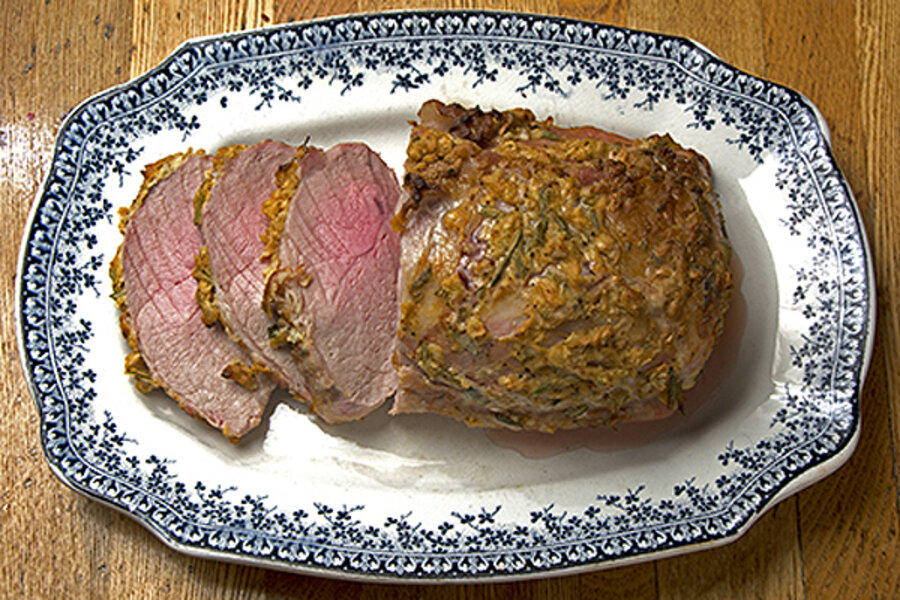Mustard-glazed pork loin roast
Loading...
We are so over winter. Two weeks ago, I reported here that we were already a foot over our annual average of three feet of snow. We have now had more than five feet of snow, and we’re not done.
The only good thing I can say about the weather is that it encourages firing up the oven and roasting savory cuts of meat. The warmth fills the entire apartment, as do wonderful, meaty fragrances. Chickens, beef pot roasts and, when I’m feeling flush, legs of lamb all spring to mind when I’m ready to roast. Somehow, though, as much as I cook with pork, I seldom think of it as a roast. This weekend, I decided it was time to fix that.
So many wonderful cuts of meat come from the pig. Pork belly is enjoying a moment right now, both as the source of bacon and in its own right. Hams, chops, ribs, shoulders, jowls and even feet, snouts, ears, and skin all yield deliciousness when properly prepared.
And therein lies the problem. With so many cuts to choose from, trying to pick the right one for the cooking technique you have in mind can be a challenge. I’d been seeing pork loin roasts in the butcher case lately. The name sounded promising, but I wanted to know more about the cut. So I checked in with the National Pork Board’s Pork Be Inspired website for more information.
According to the site, the loin roast “comes from the area of the pig between the shoulder and the beginning of the leg It is sold either bone-in or deboned.” Even though it is right next to the shoulder, a versatile cut that lends itself to roasting, braising and stewing, the loin roast has “a tendency to lose tenderness and fall apart when cooked using moist heat.” Roasting and indirect grilling are the best techniques for cooking this cut.
Boneless loin roasts are typically cut into 2- to 4-pound pieces and include a nice thin layer of fat. The handsome one I bought this weekend was about 2-1/2 pounds. Because of the name, loin roasts are sometimes confused with the smaller, longer pork tenderloin. As you can see, it is not the same thing.
As with many cuts of pork, loin roasts take well to brining, spice rubs and glazes. For this recipe, I made a glaze of Dijon mustard, shallots, rosemary, garlic, coarse kosher salt, and black pepper. After coating the roast with the glaze, I wrapped it in plastic and let it rest in the fridge for several hours. This gave the meat a chance to absorb some of the flavor – and for the various flavors of the glaze to meld.
Besides being a flavorful, tender roast the day you make it, the roast leftovers make delicious sandwiches.
Mustard-glazed pork loin roast
Serves 6 to 8
1/4 cup Dijon mustard
1 tablespoon chopped fresh rosemary
3 tablespoons minced shallots
1 tablespoon minced garlic
1/2 teaspoon coarse kosher salt
1 teaspoon freshly ground black pepper
Pork loin roast, about 2-1/2 pounds
1. Combine first six ingredients in a small bowl. Spread a sheet of plastic wrap large enough to completely wrap the loin roast on a counter or table. Lay the roast fat side down in the center of the plastic sheet. Using your hands, spread mustard glaze over the bottom of the roast and then turn it fat side up. Spread mustard glaze over the top, sides and ends of the roast, coating all surfaces. Wrap in plastic wrap, place on a plate (in case of any leakage of glaze) and refrigerate for at least 4 hours and up to overnight.
2. About 30 minutes before you’re ready to cook the roast, take it from the fridge (and remove it from the chilled plate) to let it warm up. Preheat the oven to 450 degrees F. Unwrap the roast and place it on a foil-lined baking sheet. Place on the center rack in the oven and roast for 20 minutes. Reduce heat to 350 degrees F., and roast until an instant read thermometer reads 145 degrees F., when inserted in the center of the roast, about 30 to 40 minutes.
3. Transfer roast to cutting board, tent with foil and let it rest about 10 minutes before carving. Slice thinly crosswise and serve.








